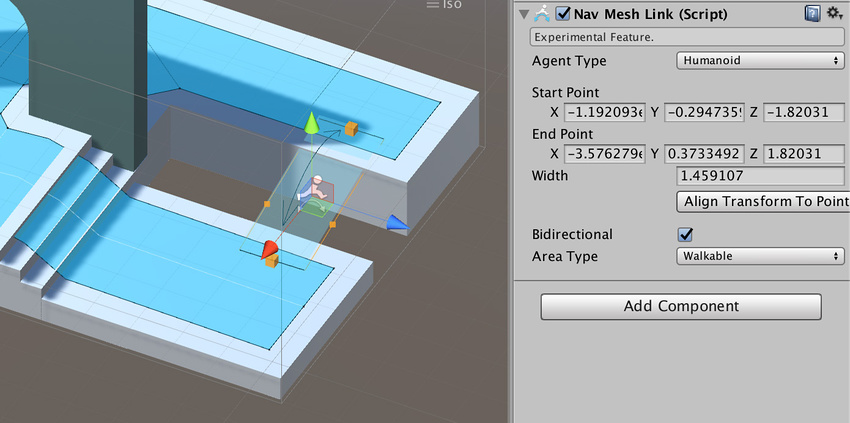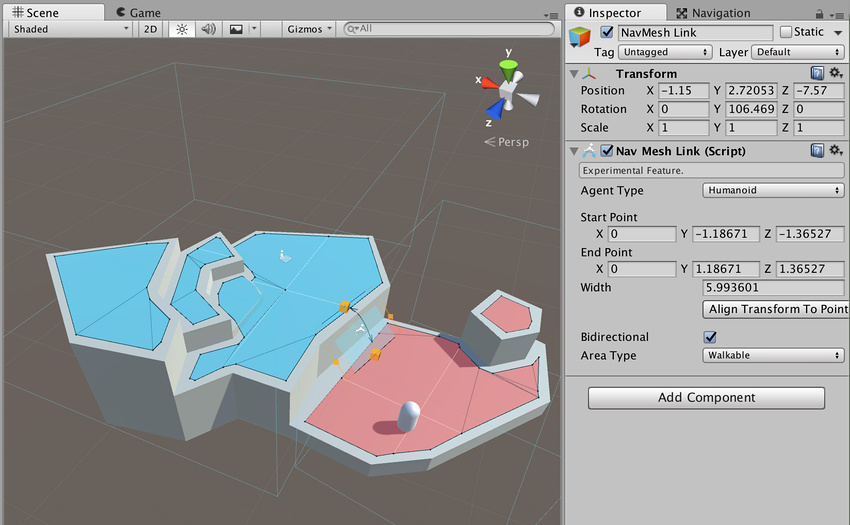NavMesh Link
The NavMeshA mesh that Unity generates to approximate the walkable areas and obstacles in your environment for path finding and AI-controlled navigation. More info
See in Glossary Link component is not in the Unity standard install; see documentation on high-level NavMesh building components for information on how to access it.
NavMesh Link creates a navigable link between two locations that use NavMeshes.
This link can be from point to point or it can span a gap, in which case the Agent uses the nearest location along the entry edge to cross the link.
You must use a NavMesh Link to connect different NavMesh Surfaces.
To use the NavMesh Link component, navigate to GameObjectThe fundamental object in Unity scenes, which can represent characters, props, scenery, cameras, waypoints, and more. A GameObject’s functionality is defined by the Components attached to it. More info
See in Glossary > AI > NavMesh Link.

| PropertyA generic term for the editable fields, buttons, checkboxes, or menus that comprise a component. An editable property is also referred to as a field. More info See in Glossary |
Function |
|---|---|
| Agent Type | The Agent type that can use the link. - Humanoid - Ogre |
| Start Point | The start point of the link, relative to the GameObject. Defined by XYZ measurements. |
| End Point | The end point of the link, relative to the GameObject. Defined by XYZ measurements. |
| Align Transform To Points | Clicking this button moves the GameObject at the link’s center point and aligns the transform’s forward axis with the end point. |
| Bidirectional | With this tickbox checked, NavMesh Agents traverse the NavMesh Link both ways (from the start point to the end point, and from the end point back to the start point). When this tickbox is unchecked, the NavMesh Link only functions one-way (from the start point to the end point only). |
| Area Type | The area type of the NavMesh Link (this affects pathfinding costs). - Walkable (this is the default option) - Not Walkable - Jump |
Connecting multiple NavMesh Surfaces together

If you want an Agent to move between multiple NavMesh Surfaces in a SceneA Scene contains the environments and menus of your game. Think of each unique Scene file as a unique level. In each Scene, you place your environments, obstacles, and decorations, essentially designing and building your game in pieces. More info
See in Glossary, they must be connected using a NavMesh Link.
In the example Scene above, the blue and red NavMeshes are defined in different NavMesh Surfaces, with a NavMesh link connecting them.
Note that when connecting NavMesh Surfaces:
You can connect NavMesh Surfaces using multiple NavMesh Links.
Both the NavMesh Surfaces and the NavMesh Link must have same Agent type.
The NavMesh Link’s start and end point must only be on one NavMesh Surface - be careful if you have multiple NavMeshes at the same location.
If you are loading a second NavMesh Surface and you have unconnected NavMesh Links in the first Scene, check that they do not connect to any unwanted NavMesh Surfaces.
2017–05–26 Page published with limited editorial review
New feature in 5.6